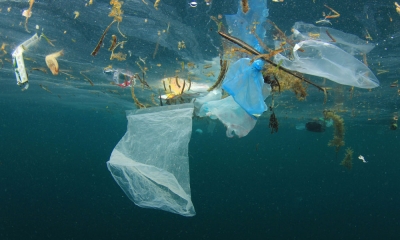
Scientists discovered a new species of marine creature in the deepest trench on Earth. In a normal scenario, this would have called for celebration. But this situation isn’t normal. Because the researchers also identified plastic in its body.
The amphipod is just two inches long and was caught at a depth of 20,000 feet in the Mariana Trench. The Mariana Trench in the Pacific Ocean is the deepest point on Earth’s surface, reaching more than 36,000 feet deep. Clearly, even this remote environment is not exempt from the impact of plastic pollution. The tiny creature had been found to have ingested tiny pieces of debris known as microplastics. The material they identified was polyethylene terephthalate (PET), common plastic widely used in food and drink packaging. To highlight the scale of marine plastic pollution crisis, researchers decided to name it Eurythenes plasticus. The creature is now one of the 240 known species to have been recorded ingesting plastic.
Plastic debris is now common throughout the world’s oceans. In fact, a 2015 study found that around eight million tones of the material enter the oceans every year. Once in water, this plastic can break down into smaller and smaller pieces, eventually becoming microplastics – frequently ingested by marine animals. Thousands of animals, from sea birds to whales, die every year from consuming or getting caught in plastic.
Pollution in Alarming scale
- According to a 2017 study, humans have produced 18.2 trillion pounds of plastic since the 1950s. Only 9% of it has been recycled and another 12% has been burnt. A majority of the plastic ends up in landfills and the oceans. The debris is often carried by wind and rain into our drainage networks and eventually into the sea.
- A report released by Ellen MacArthur Foundation at the World Economic Forum in 2016 estimated that at least eight million tones of plastics leak into the ocean – this is equal to dumping the contents of one garbage truck into the ocean every minute. The report further says the ocean is expected to contain one tonne of plastic for every three tonnes of fish by 2025, and by 2025, there will be more plastic than fish by weight in the ocean.
What are microplastics?
Most plastic in the ocean break down into very small particles called microplastics and make their way into the system of marine animals. Plastic particles that are less than five mm long are called microplastics. Microplastics come from a variety of sources, and are of two types – one that are manufactured (microbeads) and the other that are derived from the breakdown of larger plastic debris. Besides water, microplastics have been found in soil and air.
How plastic affects marine ecosystem
Sea turtles and other marine creatures mistake plastics for food (such as jellyfish) and ingest them. This causes blockage in their digestive system, leading to their death. Studies have found that plastic pollution can also affect sea turtles’ reproductive system.
In sea birds, plastic ingestion reduces the storage volume of the stomach, causing starvation and death.
Besides ingestion, marine mammals get tangled up in plastic, leading to their death.
Plastic may also get transferred along the food chain – from fish to bigger fish or marine mammals and finally to human seafood consumers.
Invisible threat
Marine species also face the invisible threat of plastic-derived chemicals. It was long held that plastic broke down only at very high temperatures and over hundreds of years. A study in 2009 showed that some plastics decompose rapidly in the ocean, even within a year of the trash hitting the water. The degrading plastics also leach potentially toxic chemicals such as bisphenol A into the seas, possibly threatening ocean animals, and human, who ultimately consume some of these creatures.
- Direct toxicity of plastics comes from lead, cadmium and mercury added to them while manufacturing plastic products. These toxin s have been found in many fish in the ocean.
- When expanded polystyrene, used especially for making food containers, breaks down, the tiny polystyrene components start to sink, as they are heavier than water. Exposure to polystyrene can cause irritation of the skin, eyes and the upper respiratory tract in humans. Acute exposure may also result in gastrointestinal effects.
- Bisphenol A (BPA) has been shown to interfere with the reproductive systems of animals. In humans, even low doses of bisphenol A can impair immune function and cause cancer, obesity, diabetes and hyperactivity, among other problems.
- Diethylhexyl phthalate (DEHP) contained in some plastics, is also carcinogenic (cancer-causing).
Picture Credit : Google
